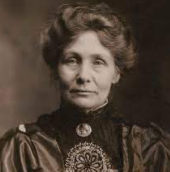Written by: Emily Vargo
In this day and age, most everyone can vote. However, this wasn’t alway the case. Growing up, we were all probably told at some point that women didn’t use to have the right to vote here in the United States,, but women couldn’t vote in many different places.
At one point, women could not vote in Great Britain, but one strong woman set out to change that. This woman is Emmeline Pankhurst.
Emmeline was born in Manchester, England, on July 15, 1858. Growing up Emmeline’s teacher called her Emily which was the name she preferred to be called by. (I may be biased, but Emily is a really cool name).

Emily was one of ten siblings and the eldest of five daughters. Emily’s father was active in local politics during her upbringing. During Emily’s childhood, her parents supported women’s suffrage however, when it came to their daughters, their suffrage views didn’t apply. They wanted their sons to get a good education while they wanted their daughters to marry young and be good homemakers.
At age 14, Emily went with her mother to a public women’s suffrage meeting where Lydia Becker was speaking. Emily was very fond of Becker, so she insisted on going, and her mother let her. A year later, she went to Paris and attended École Normale de Neuilly, where she could learn subjects such as chemistry as well as bookkeeping and embroidering.
On December 18, 1879, Emily married Richard Pankhurst, who was an advocate for women’s suffrage. They moved to London and had five children together, and even though Emily tended to her family and house, she would find time to work in politics, especially in the women’s suffrage movement.
Emily and her husband created the Women’s Franchise League, which was dedicated to all women. The group was considered a radical group due to their support for equal rights for women in areas such as divorce and inherence. This group didn’t last very long because of fights and tension from other groups, which caused members to leave.
In 1893 Emily and her family moved back to Manchester, and Emily started to work with several political organizations as her person and gained respect in her community.
For a while, Emily was active in thWomen’s’s Liberal Federation until 1888, where she then joined the Independent Labour Party national. One of her first activities of being part of the LPN was distributing food to poor men and women through the Committee for the Relief of the Unemployed. Then in December of 1894, she was elected to the position of Poor Law Guardian in Chorlton-on-Medlock. Emily was able to witness the working conditions firsthand and was appalled. Immediately Emily began to change the working conditions for the better.
On July 7, 189Emily’sy’s husband Richard passed away. She had to take a new position in the family and get a paid job to help the family. Emily got a job as a birth and death registrar. This job led her to write an autobiography and gave her the courage to run and get elected to the Manchester school board.
On October 10, 1903, Emily and serval colleagues founded Women’sen’s Social and Political Union. The organization was only open to women and focused on winning the vote directly. This group would eventually be known as a political party. This party would host rallies, protests, and make newsletters.
Emily was arrested several times due to protesting and spitting on officers.
Many people in her political party had to learn how to protect Emily because police would go straight for her during protests. Eventually, in 1918, women had the right to vote. If it wasn’t for Emily, it would have taken women much longer to have the simple right to vote.
Despite her hardships, she never stopped fighting fowomen’s’s rights, leaving an amazing legacy behind.
Leave a Reply
You must be logged in to post a comment.